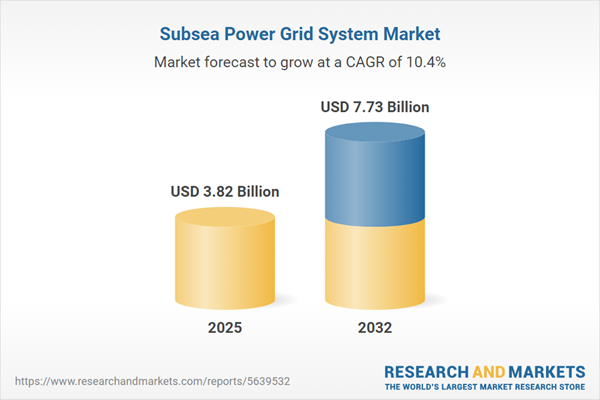Speak directly to the analyst to clarify any post sales queries you may have.
The subsea power grid system market is poised for strong, sustained growth as both public and private sector leaders seek more resilient, efficient solutions to connect offshore energy infrastructure. Accelerated demand for offshore wind, hydrocarbons, and grid modernization is reshaping the competitive landscape and driving new opportunities for scalable, digitally enabled subsea networks.
Market Snapshot: Subsea Power Grid System Market Size and Forecast
The global subsea power grid system market grew from USD 3.49 billion in 2024 to USD 3.82 billion in 2025. This forward momentum will be sustained, with the market expected to expand at a CAGR of 10.44% and reach USD 7.73 billion by 2032. Growth is propelled by rising offshore development, requirements for grid reliability, and adoption of advanced electric components across subsea platforms.
Scope & Segmentation of the Subsea Power Grid System Market
This report delivers a comprehensive analysis of the subsea power grid system market, highlighting competitive technologies and critical regional, technological, and end-user trends.
- Component Types: Cables (copper, fiber optic), switchgear (air insulated, gas insulated), transformers (step-down, step-up), and variable speed drives.
- Installation Types: Fixed and floating installations, as well as new installation projects and retrofit upgrades.
- Power Ratings: High voltage, medium voltage, and low voltage lines, servicing diverse grid and platform requirements.
- End-User Verticals: Oil and gas platforms, renewable energy projects, and utility interconnections.
- Regional Coverage: Americas (United States, Canada, Mexico, Brazil, Argentina, Chile, Colombia, Peru), Europe, Middle East & Africa (United Kingdom, Germany, France, Russia, Italy, Spain, Netherlands, Sweden, Poland, Switzerland, UAE, Saudi Arabia, Qatar, Turkey, Israel, South Africa, Nigeria, Egypt, Kenya), and Asia-Pacific (China, India, Japan, Australia, South Korea, Indonesia, Thailand, Malaysia, Singapore, Taiwan).
- Key Companies Profiled: ABB Ltd., Aibel AS., Aker Solutions ASA, Baker Hughes Company, DeepOcean, General Electric Company, Hitachi Energy Ltd., IHC Merwede Holding B.V., JDR Cable Systems Ltd., LS Cable & System Ltd., McDermott International, Ltd, Nexans S.A., NKT A/S, Oceaneering International, Inc, Prysmian Group, SAIPEM SpA, Schneider Electric SE, Siemens AG, Sumitomo Electric Industries, Ltd., and ZTT International Limited.
Key Takeaways for Senior Decision-Makers
- Technology innovations such as high-voltage direct current (HVDC) transmission, superconducting cables, and embedded fiber optic sensors are central to reducing transmission losses and elevating predictive maintenance capabilities.
- Digitalization—including digital twins, smart switchgear, and analytics platforms—enables real-time monitoring, scenario modeling, and effective risk mitigation across distributed, complex offshore networks.
- Market segmentation across cable type, switchgear selection, and transformer rating allows tailored solutions for the full spectrum of offshore projects, from floating wind farms to legacy oil and gas installations.
- Regional strategies must adapt to varying regulatory climates and local content rules, requiring supply chain flexibility and integration of region-specific installation methods.
- Sustainability imperatives are prompt manufacturers to incorporate recyclable materials and energy-efficient technology, strengthening the market’s alignment with global decarbonization goals.
- Collaborative partnerships between OEMs, technology firms, and end users foster agile procurement and innovative, tariff-optimized system designs.
Tariff Impact: Navigating Trade Policy Shifts
The implementation of United States tariffs in 2025 on imported electrical components has triggered industry-wide adjustments in supply chain strategy and procurement. Companies are diversifying sourcing, considering nearshoring, and embedding tariff risk clauses in contracts to mitigate project cost volatility. The requirement for agile engineering and strategic supplier partnerships is more important than ever, particularly for high-specification components subject to regulatory scrutiny.
Methodology & Data Sources
This analysis combines an exhaustive literature review, in-depth primary interviews with industry stakeholders, and thorough vetting of secondary data sources. Findings have been triangulated and peer-reviewed for data integrity and market relevance, ensuring a robust perspective on technical specifications and regulatory frameworks.
Why This Report Matters for Subsea Power Grid Stakeholders
- Empowers executives to swiftly identify regional and technology trends shaping the competitive landscape.
- Supports procurement and operational planning with actionable insights on regulatory, technical, and supply chain variables.
- Equips leadership with knowledge to optimize project investments, enhance risk management, and capture scalable growth.
Conclusion
Subsea power grid systems are transforming offshore energy networks, propelled by advanced technologies, regional policy shifts, and sustainability commitments. Strategic, data-driven decisions will be essential to seize new opportunities and manage the complexities of this evolving market.
Additional Product Information:
- Purchase of this report includes 1 year online access with quarterly updates.
- This report can be updated on request. Please contact our Customer Experience team using the Ask a Question widget on our website.
Table of Contents
3. Executive Summary
4. Market Overview
7. Cumulative Impact of Artificial Intelligence 2025
Companies Mentioned
The companies profiled in this Subsea Power Grid System market report include:- ABB Ltd.
- Aibel AS.
- Aker Solutions ASA
- Baker Hughes Company
- DeepOcean
- General Electric Company
- Hitachi Energy Ltd.
- IHC Merwede Holding B.V.
- JDR Cable Systems Ltd.
- LS Cable & System Ltd.
- McDermott International, Ltd
- Nexans S.A.
- NKT A/S
- Oceaneering International, Inc
- Prysmian Group
- SAIPEM SpA
- Schneider Electric SE
- Siemens AG
- Sumitomo Electric Industries, Ltd.
- ZTT International Limited
Table Information
| Report Attribute | Details |
|---|---|
| No. of Pages | 189 |
| Published | November 2025 |
| Forecast Period | 2025 - 2032 |
| Estimated Market Value ( USD | $ 3.82 Billion |
| Forecasted Market Value ( USD | $ 7.73 Billion |
| Compound Annual Growth Rate | 10.4% |
| Regions Covered | Global |
| No. of Companies Mentioned | 21 |









